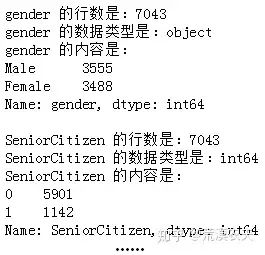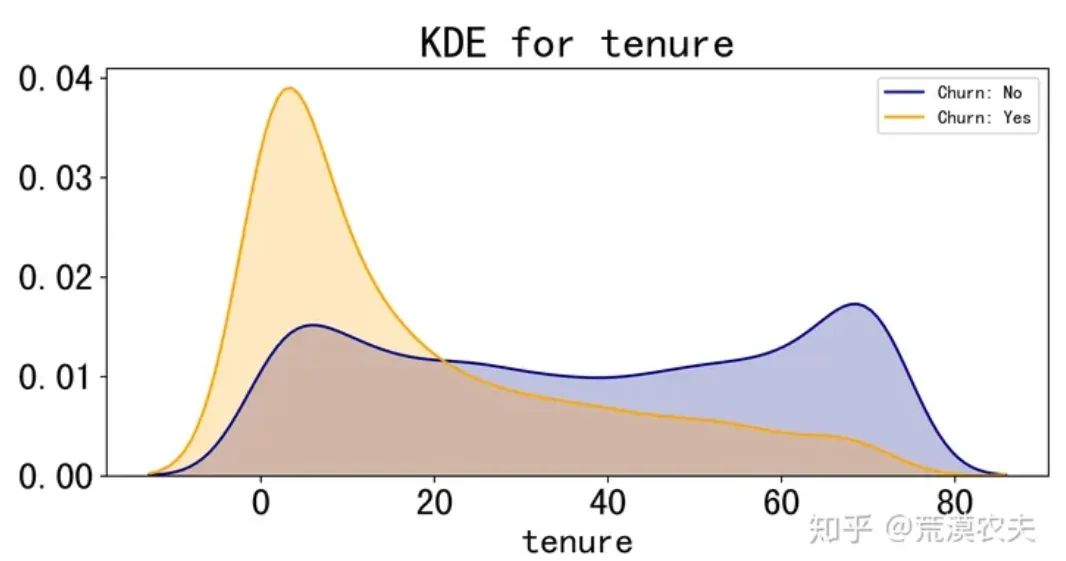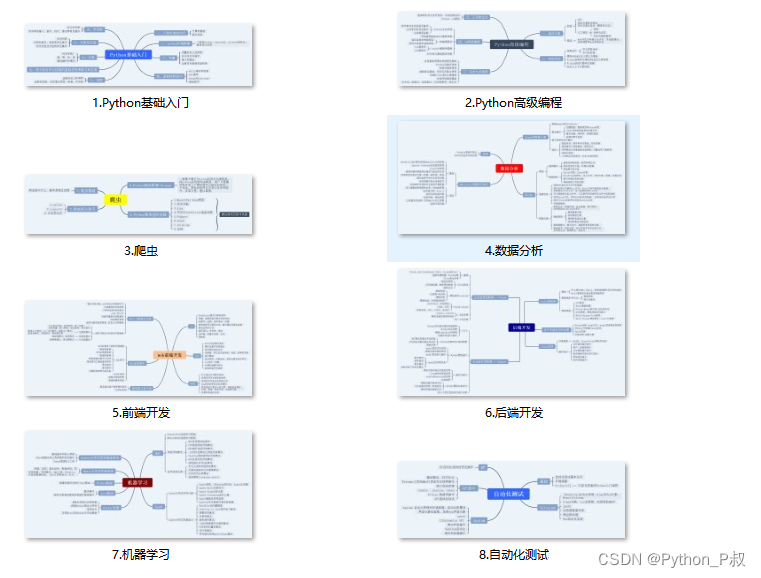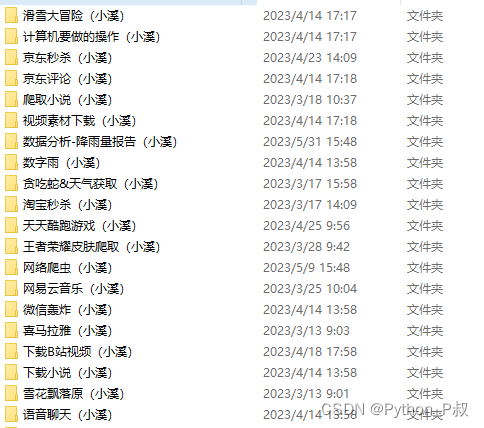今天这篇文章将给大家介绍电信用户流失分析与预测分析案例。
关于用户留存有这样一个观点:如果将用户流失率降低5%,公司利润将提升25%-85%。
如今高居不下的获客成本让电信运营商遭遇“天花板”,甚至陷入获客难的窘境。随着市场饱和度上升,电信运营商亟待解决增加用户黏性,延长用户生命周期的问题。因此,电信用户流失分析与预测至关重要。
01
提出问题
1、分析用户特征与流失的关系。
2、从整体情况看,流失用户的普遍具有哪些特征?
3、尝试找到合适的模型预测流失用户。
4、针对性给出增加用户黏性、预防流失的建议。
02
数据理解
数据来源:
https://www.kaggle.com/datasets/blastchar/telco-customer-churn
根据介绍,该数据集有21个字段,共7043条记录。每条记录包含了唯一客户的特征。
利用Jupyter Notebook工具,采用Python结合matplotlib、seaborn、sklearn等工具包进行进行用户流失可视化分析和预测。
03
数据清洗
数据清洗的“完全合一”规则:
1. 完整性:单条数据是否存在空值,统计的字段是否完善。
2. 全面性:观察某一列的全部数值,通过常识来判断该列是否有问题。比如:数据定义、单位标识、数据本身。
3. 合法性:数据的类型、内容、大小的合法性。比如:数据中是否存在非ASCII字符,性别存在了未知,年龄超过了150等。
4. 唯一性:数据是否存在重复记录,因为数据通常来自不同渠道的汇总,重复的情况是常见的。行数据、列数据都需要是唯一的。
导入工具包
#!/user/bin/env python 3``import pandas as pd``import numpy as np``import matplotlib.pylab as plt``import seaborn as sns
导入数据集文件
# 使用open方法可以在路径中包含中文``f=open('C:/Users/MQ/Desktop/电信客户流失数据/WA_Fn-UseC_-Telco-Customer-Churn.csv')``customerDf=pd.read_csv(f)
查看数据集信息,查看数据集大小,并初步观察前10条的数据内容
# 查看数据集大小``customerDf.shape``# 运行结果:(7043, 21)`` ``# 设置查看列不省略``pd.set_option('display.max_columns',None)`` ``# 查看前10条数据``customerDf.head(10)
查看数据是否存在Null,没有发现
# Null计数``pd.isnull(customerDf).sum()
输出结果:
查看数据类型
根据一般经验,发现‘TotalCharges’总消费额的数据类型为字符串,应该转换为浮点型数据。
# 查看数据类型``customerDf.info()``#customerDf.dtypes
输出结果:
将‘TotalCharges’总消费额的数据类型转换为**浮点型,**发现错误:字符串无法转换为数字。
#customerDf[['TotalCharges']].astype(float)``#ValueError: could not convert string to float:
依次检查各个字段的数据类型、字段内容和数量。
最后发现“TotalCharges”(总消费额)列有11个用户数据缺失。
# 查看每一列数据取值``for x in customerDf.columns:` `test=customerDf.loc[:,x].value_counts()` `print('{0} 的行数是:{1}'.format(x,test.sum()))` `print('{0} 的数据类型是:{1}'.format(x,customerDf[x].dtypes))` `print('{0} 的内容是:\n{1}\n'.format(x,test))
输出结果:
采用强制转换
#强制转换为数字,不可转换的变为NaN``customerDf['TotalCharges']=customerDf['TotalCharges'].convert_objects(convert_numeric=True)
转换后发现“TotalCharges”(总消费额)列有11个用户数据缺失,为NaN。
test=customerDf.loc[:,'TotalCharges'].value_counts().sort_index()``print(test.sum())``运行结果:7032`` ``pd.isnull(customerDf['TotalCharges']).sum()``运行结果:11
经过观察,发现这11个用户‘tenure’(入网时长)为0个月,推测是当月新入网用户。
根据一般经验,用户即使在注册的当月流失,也需缴纳当月费用。因此将这11个用户入网时长改为1,将总消费额填充为月消费额,符合实际情况。
print(customerDf.isnull().any())``print(customerDf[customerDf['TotalCharges']!=customerDf['TotalCharges']][['tenure','MonthlyCharges','TotalCharges']])
输出结果:
#将总消费额填充为月消费额``customerDf.loc[:,'TotalCharges'].replace(to_replace=np.nan,value=customerDf.loc[:,'MonthlyCharges'],inplace=True)``#查看是否替换成功``print(customerDf[customerDf['tenure']==0][['tenure','MonthlyCharges','TotalCharges']])
输出结果:
# 将‘tenure’入网时长从0修改为1``customerDf.loc[:,'tenure'].replace(to_replace=0,value=1,inplace=True)``print(pd.isnull(customerDf['TotalCharges']).sum())``print(customerDf['TotalCharges'].dtypes)``运行结果:``0``float64
查看数据的描述统计信息,根据一般经验,所有数据正常。
# 获取数据类型的描述统计信息``customerDf.describe()
输出结果:
04
可视化分析
根据一般经验,将用户特征划分为用户属性、服务属性、合同属性,并从这三个维度进行可视化分析。
查看流失用户数量和占比
#保存图片自定义函数``def savePic(name):``#bounding box_inches(边框英寸)设置,保存的图片去掉周围空白` `plt.savefig('C:/Users/MQ/Desktop/电信客户流失数据/图片/{0}.png'.format(name), dpi=600,bbox_inches='tight')`` ``plt.rcParams['figure.figsize']=6,6``plt.pie(customerDf['Churn'].value_counts(),labels=customerDf['Churn'].value_counts().index,autopct='%1.2f%%',explode=(0.1,0))``plt.title('Churn(Yes/No) Ratio')``savePic('Churn(Yes or No) Ratio')``plt.show()
输出结果:
# 使用catplot需要安装seaborn V0.9.0:conda install seaborn==0.9.0``churnDf=customerDf['Churn'].value_counts().to_frame()``x=churnDf.index``y=churnDf['Churn']``plt.bar(x,y,width = 0.5,color = 'c')`` ``#用来正常显示中文标签(需要安装字库)``plt.rcParams['font.sans-serif']=['SimHei']` `plt.rcParams.update({'font.size': 18})``plt.title('Churn(Yes/No) Num')``for a,b in zip(x,y):` `plt.text(a,b+10,'%.0f' % b, ha='center', va= 'bottom')``savePic('Churn(Yes or No) Num')``plt.show()
输出结果:
属于不平衡数据集,流失用户占比达26.54%。
用户属性分析
def barplot_percentages(feature,orient='v',axis_name="percentage of customers"):` `ratios = pd.DataFrame()` `g = (customerDf.groupby(feature)["Churn"].value_counts()/len(customerDf)).to_frame()` `g.rename(columns={"Churn":axis_name},inplace=True)` `g.reset_index(inplace=True)`` ` `#print(g)` `if orient == 'v':` `ax = sns.barplot(x=feature, y= axis_name, hue='Churn', data=g, orient=orient)` `ax.set_yticklabels(['{:,.0%}'.format(y) for y in ax.get_yticks()])` `plt.rcParams.update({'font.size': 13})` `#plt.legend(fontsize=10)` `else:` `ax = sns.barplot(x= axis_name, y=feature, hue='Churn', data=g, orient=orient)` `ax.set_xticklabels(['{:,.0%}'.format(x) for x in ax.get_xticks()])` `plt.legend(fontsize=10)` `plt.title('Churn(Yes/No) Ratio as {0}'.format(feature))` `savePic('Churn(Yes or No) Ratio as {0}'.format(feature))` `plt.show()``barplot_percentages("SeniorCitizen")``barplot_percentages("gender")
输出结果:
customerDf['churn_rate'] = customerDf['Churn'].replace("No", 0).replace("Yes", 1)``g = sns.FacetGrid(customerDf, col="SeniorCitizen", height=4, aspect=.9)``ax = g.map(sns.barplot, "gender", "churn_rate", palette = "Blues_d", order= ['Female', 'Male'])``plt.rcParams.update({'font.size': 13})``savePic('Churn(Yes or No) Ratio as gender and SeniorCitizen')``plt.show()
输出结果:
小结:
1、 用户流失与性别基本无关。
2、年老用户流失占比显著高于年轻用户。
fig, axis = plt.subplots(1, 2, figsize=(12,4))``axis[0].set_title("Has Partner")``axis[1].set_title("Has Dependents")``axis_y = "percentage of customers"`` ``# Plot Partner column``gp_partner = (customerDf.groupby('Partner')["Churn"].value_counts()/len(customerDf)).to_frame()``gp_partner.rename(columns={"Churn": axis_y}, inplace=True)``gp_partner.reset_index(inplace=True)``ax1 = sns.barplot(x='Partner', y= axis_y, hue='Churn', data=gp_partner, ax=axis[0])``ax1.legend(fontsize=10)``#ax1.set_xlabel('伴侣')`` `` ``# Plot Dependents column``gp_dep = (customerDf.groupby('Dependents')["Churn"].value_counts()/len(customerDf)).to_frame()``#print(gp_dep)``gp_dep.rename(columns={"Churn": axis_y} , inplace=True)``#print(gp_dep)``gp_dep.reset_index(inplace=True)``#print(gp_dep)`` ``ax2 = sns.barplot(x='Dependents', y= axis_y, hue='Churn', data=gp_dep, ax=axis[1])``#ax2.set_xlabel('家属')`` `` ``#设置字体大小``plt.rcParams.update({'font.size': 20})``ax2.legend(fontsize=10)`` ``#设置``savePic('Churn(Yes or No) Ratio as partner and dependents')``plt.show()
输出结果:
# Kernel density estimaton核密度估计``def kdeplot(feature,xlabel):` `plt.figure(figsize=(9, 4))` `plt.title("KDE for {0}".format(feature))` `ax0 = sns.kdeplot(customerDf[customerDf['Churn'] == 'No'][feature].dropna(), color= 'navy', label= 'Churn: No', shade='True')` `ax1 = sns.kdeplot(customerDf[customerDf['Churn'] == 'Yes'][feature].dropna(), color= 'orange', label= 'Churn: Yes',shade='True')` `plt.xlabel(xlabel)` `#设置字体大小` `plt.rcParams.update({'font.size': 20})` `plt.legend(fontsize=10)``kdeplot('tenure','tenure')``savePic('Churn(Yes or No) Ratio as tenure kde')``plt.show()
输出结果:
小结:
1、有伴侣的用户流失占比****低于无伴侣用户。
2、有****家属的用户较少。
3、有家属的用户流失占比低于无家属用户。
4、在网时长越久,流失率越低,符合一般经验。
5、在网时间达到三个月,流失率小于在网率,证明用户心理稳定期一般是三个月。
服务属性分析
plt.figure(figsize=(9, 4.5))``barplot_percentages("MultipleLines", orient='h')
输出结果:
plt.figure(figsize=(9, 4.5))``barplot_percentages("InternetService", orient="h")
输出结果:
cols = ["PhoneService","MultipleLines","OnlineSecurity", "OnlineBackup", "DeviceProtection", "TechSupport", "StreamingTV", "StreamingMovies"]``df1 = pd.melt(customerDf[customerDf["InternetService"] != "No"][cols])``df1.rename(columns={'value': 'Has service'},inplace=True)``plt.figure(figsize=(20, 8))``ax = sns.countplot(data=df1, x='variable', hue='Has service')``ax.set(xlabel='Internet Additional service', ylabel='Num of customers')``plt.rcParams.update({'font.size':20})``plt.legend( labels = ['No Service', 'Has Service'],fontsize=15)``plt.title('Num of Customers as Internet Additional Service')``savePic('Churn(Yes or No) Num as Internet Additional Service')``plt.show()
输出结果:
plt.figure(figsize=(20, 8))``df1 = customerDf[(customerDf.InternetService != "No") & (customerDf.Churn == "Yes")]``df1 = pd.melt(df1[cols])``df1.rename(columns={'value': 'Has service'}, inplace=True)``ax = sns.countplot(data=df1, x='variable', hue='Has service', hue_order=['No', 'Yes'])``ax.set(xlabel='Internet Additional service', ylabel='Churn Num')``plt.rcParams.update({'font.size':20})``plt.legend( labels = ['No Service', 'Has Service'],fontsize=15)``plt.title('Num of Churn Customers as Internet Additional Service')``savePic('Churn Num as Internet Additional Service')``plt.show()
输出结果:
小结:
1、电话服务整体对用户流失影响较小。
2、单光纤用户的流失占比较高。
3、光纤****用户绑定了安全、备份、保护、技术支持服务的流失率较低。
4、光纤用户附加流媒体电视、电影服务的流失率占比较高。
合同属性分析
plt.figure(figsize=(9, 4.5))``barplot_percentages("PaymentMethod",orient='h')
输出结果:
g = sns.FacetGrid(customerDf, col="PaperlessBilling", height=6, aspect=.9)``ax = g.map(sns.barplot, "Contract", "churn_rate", palette = "Blues_d", order= ['Month-to-month', 'One year', 'Two year'])``plt.rcParams.update({'font.size':18})``savePic('Churn Ratio as PaperlessBilling')``plt.show()
输出结果:
kdeplot('MonthlyCharges','MonthlyCharges')``savePic('Churn(Yes or No) Ratio as MonthlyCharges kde')``kdeplot('TotalCharges','TotalCharges')``savePic('Churn(Yes or No) Ratio as TotalCharges kde')``plt.show()
输出结果:
小结:
1、采用电子支票支付的用户流失率最高,推测该方式的使用体验较为一般。
2、签订合同方式对客户流失率影响为:按月签订 > 按一年签订 > 按两年签订,证明长期合同最能保留客户。
3、月消费额大约在70-110之间用户流失率较高。
4、长期来看,用户总消费越高,流失率越低,符合一般经验。
通过以上分析,可以得到较高流失率的人群特征,具有这些特征的人群需要对其进行运营,增加用户黏性,延长其生命周期价值。
05
用户流失预测
对数据集进一步清洗和提取特征,通过特征选取对数据进行降维,采用机器学习模型应用于测试数据集,然后对构建的分类模型****准确性进行分析。
数据清洗
customerID=customerDf['customerID']``customerDf.drop(['customerID'],axis=1, inplace=True)
观察数据类型发现:
大多除了**“tenure”、“MonthlyCharges”、“TotalCharges”是连续特征**,其它都是离散特征。
对于连续特征,采用标准化方式处理。对于离散特征,特征之间没有****大小关系,采用one-hot编码;特征之间有大小关联,则采用数值映射。
获取离散特征
cateCols = [c for c in customerDf.columns if customerDf[c].dtype == 'object' or c == 'SeniorCitizen']``dfCate = customerDf[cateCols].copy()``dfCate.head(3)
进行特征编码
for col in cateCols:` `if dfCate[col].nunique() == 2:` `dfCate[col] = pd.factorize(dfCate[col])[0]` `else:` `dfCate = pd.get_dummies(dfCate, columns=[col])``dfCate['tenure']=customerDf[['tenure']]``dfCate['MonthlyCharges']=customerDf[['MonthlyCharges']]``dfCate['TotalCharges']=customerDf[['TotalCharges']]
查看关联关系
plt.figure(figsize=(16,8))``dfCate.corr()['Churn'].sort_values(ascending=False).plot(kind='bar')``plt.show()
输出结果:
特征选取
# 特征选择``dropFea = ['gender','PhoneService',` `'OnlineSecurity_No internet service', 'OnlineBackup_No internet service',` `'DeviceProtection_No internet service', 'TechSupport_No internet service',` `'StreamingTV_No internet service', 'StreamingMovies_No internet service',` `#'OnlineSecurity_No', 'OnlineBackup_No',` `#'DeviceProtection_No','TechSupport_No',` `#'StreamingTV_No', 'StreamingMovies_No',` `]``dfCate.drop(dropFea, inplace=True, axis =1)` `#最后一列是作为标识``target = dfCate['Churn'].values``#列表:特征和1个标识``columns = dfCate.columns.tolist()
构造训练数据集和测试数据集
# 列表:特征``columns.remove('Churn')``# 含有特征的DataFrame``features = dfCate[columns].values``# 30% 作为测试集,其余作为训练集``# random_state = 1表示重复试验随机得到的数据集始终不变``# stratify = target 表示按标识的类别,作为训练数据集、测试数据集内部的分配比例``train_x, test_x, train_y, test_y = train_test_split(features, target, test_size=0.30, stratify = target, random_state = 1)
构建模型
# 构造各种分类器``classifiers = [` `SVC(random_state = 1, kernel = 'rbf'),`` DecisionTreeClassifier(random_state = 1, criterion = 'gini'),` `RandomForestClassifier(random_state = 1, criterion = 'gini'),` `KNeighborsClassifier(metric = 'minkowski'),` `AdaBoostClassifier(random_state = 1),` `]``# 分类器名称``classifier_names = [` `'svc',`` 'decisiontreeclassifier',` `'randomforestclassifier',` `'kneighborsclassifier',` `'adaboostclassifier',``]``# 分类器参数``#注意分类器的参数,字典键的格式,GridSearchCV对调优的参数格式是"分类器名"+"__"+"参数名"``classifier_param_grid = [` `{'svc__C':[0.1], 'svc__gamma':[0.01]},` `{'decisiontreeclassifier__max_depth':[6,9,11]},` `{'randomforestclassifier__n_estimators':range(1,11)} ,` `{'kneighborsclassifier__n_neighbors':[4,6,8]},` `{'adaboostclassifier__n_estimators':[70,80,90]}``]
模型参数调优和评估
对分类器进行参数调优和评估得到试用**AdaBoostClassifier(n_estimators=80)**效果最好。
# 对具体的分类器进行 GridSearchCV 参数调优``def GridSearchCV_work(pipeline, train_x, train_y, test_x, test_y, param_grid, score = 'accuracy_score'):` `response = {}` `gridsearch = GridSearchCV(estimator = pipeline, param_grid = param_grid, cv=3, scoring = score)` `# 寻找最优的参数 和最优的准确率分数` `search = gridsearch.fit(train_x, train_y)` `print("GridSearch 最优参数:", search.best_params_)` `print("GridSearch 最优分数:%0.4lf" %search.best_score_)` `#采用predict函数(特征是测试数据集)来预测标识,预测使用的参数是上一步得到的最优参数` `predict_y = gridsearch.predict(test_x)` `print(" 准确率 %0.4lf" %accuracy_score(test_y, predict_y))` `response['predict_y'] = predict_y` `response['accuracy_score'] = accuracy_score(test_y,predict_y)` `return response` `for model, model_name, model_param_grid in zip(classifiers, classifier_names, classifier_param_grid):` `#采用 StandardScaler 方法对数据规范化:均值为0,方差为1的正态分布` `pipeline = Pipeline([` `#('scaler', StandardScaler()),` `#('pca',PCA),` `(model_name, model)` `])` `result = GridSearchCV_work(pipeline, train_x, train_y, test_x, test_y, model_param_grid , score = 'accuracy')`` ``运行结果:``GridSearch 最优参数:{'svc__C': 0.1, 'svc__gamma': 0.01}``GridSearch 最优分数:0.7884` `准确率 0.7823``GridSearch 最优参数:{'decisiontreeclassifier__max_depth': 6}``GridSearch 最优分数:0.7911` `准确率 0.7695``GridSearch 最优参数:{'randomforestclassifier__n_estimators': 10}``GridSearch 最优分数:0.7840` `准确率 0.7624``GridSearch 最优参数:{'kneighborsclassifier__n_neighbors': 8}``GridSearch 最优分数:0.7917` `准确率 0.7733``GridSearch 最优参数:{'adaboostclassifier__n_estimators': 80}``GridSearch 最优分数:0.8039` `准确率 0.7960
实施方案
由于没有预测数据集,选择最后10条数据为例进行预测。
# 使用上述得到的最优模型``model = AdaBoostClassifier(n_estimators=80)``model.fit(train_x,train_y)`` ``# 提取customerID``pred_id = customerID.tail(10)``# 提取预测数据集特征(如果有预测数据集,可以一并进行数据清洗和特征提取)``pred_x = dfCate.drop(['Churn'],axis=1).tail(10)`` ``# 预测值``pred_y = model.predict(pred_x)`` ``# 预测结果``predDf = pd.DataFrame({'customerID':pred_id, 'Churn':pred_y})``print(predDf)
输出结果:
06
结论和建议
根据以上分析,得到高流失率用户的特征:
1、用户属性:老年用户,未婚用户,无亲属用户更容易流失。
2、服务属性:在网时长小于半年,有电话服务,光纤用户/光纤用户附加流媒体电视、电影服务,无互联网增值服务。
3、合同属性:签订的合同期较短,采用电子支票支付,是电子账单,月租费约70-110元的客户容易流失。
4、其它属性对用户流失影响较小,以上特征保持独立。
针对上述结论,从业务角度给出相应建议:
1、根据预测模型,构建一个高流失率的用户列表。
通过用户调研推出一个最小可行化产品功能,并邀请种子用户进行试用。
2、用户方面:针对老年用户、无亲属、无伴侣用户的特征退出定制服务。
如:亲属套餐、温暖套餐等,一方面加强与其它用户关联度,另一方对特定用户提供个性化服务。
3、服务方面:针对新注册用户,推送半年优惠,如:赠送消费券,以渡过用户流失高峰期。
针对光纤用户和附加流媒体电视、电影服务用户,重点在于提升网络体验、增值服务体验,一方面推动技术部门提升网络指标,另一方面对用户承诺免费网络升级和赠送电视、电影等包月服务以提升用户黏性。
针对在线安全、在线备份、设备保护、技术支持等增值服务,应重点对用户进行推广介绍,如首月/半年免费体验。
4、合同方面:针对单月合同用户,建议推出年合同付费折扣活动,将月合同用户转化为年合同用户,提高用户在网时长,以达到更高的用户留存。
针对采用电子支票支付用户,建议定向推送其它支付方式的优惠券,引导用户改变支付方式。
案例来源:
https://zhuanlan.zhihu.com/p/68397317
题外话
感兴趣的小伙伴,赠送全套Python学习资料,包含面试题、简历资料等具体看下方。
👉CSDN大礼包🎁:全网最全《Python学习资料》免费赠送🆓!(安全链接,放心点击)
一、Python所有方向的学习路线
Python所有方向的技术点做的整理,形成各个领域的知识点汇总,它的用处就在于,你可以按照下面的知识点去找对应的学习资源,保证自己学得较为全面。
二、Python必备开发工具
工具都帮大家整理好了,安装就可直接上手!
三、最新Python学习笔记
当我学到一定基础,有自己的理解能力的时候,会去阅读一些前辈整理的书籍或者手写的笔记资料,这些笔记详细记载了他们对一些技术点的理解,这些理解是比较独到,可以学到不一样的思路。
四、Python视频合集
观看全面零基础学习视频,看视频学习是最快捷也是最有效果的方式,跟着视频中老师的思路,从基础到深入,还是很容易入门的。
五、实战案例
纸上得来终觉浅,要学会跟着视频一起敲,要动手实操,才能将自己的所学运用到实际当中去,这时候可以搞点实战案例来学习。
六、面试宝典
简历模板
👉CSDN大礼包🎁:全网最全《Python学习资料》免费赠送🆓!(安全链接,放心点击)
若有侵权,请联系删除

































